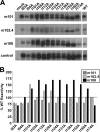Residues in the stalk domain of the hendra virus g glycoprotein modulate conformational changes associated with receptor binding
- PMID: 18799571
- PMCID: PMC2573269
- DOI: 10.1128/JVI.02654-07
Residues in the stalk domain of the hendra virus g glycoprotein modulate conformational changes associated with receptor binding
Abstract
Hendra virus (HeV) is a member of the broadly tropic and highly pathogenic paramyxovirus genus Henipavirus. HeV is enveloped and infects cells by using membrane-anchored attachment (G) and fusion (F) glycoproteins. G possesses an N-terminal cytoplasmic tail, an external membrane-proximal stalk domain, and a C-terminal globular head that binds the recently identified receptors ephrinB2 and ephrinB3. Receptor binding is presumed to induce conformational changes in G that subsequently trigger F-mediated fusion. The stalk domains of other attachment glycoproteins appear important for oligomerization and F interaction and specificity. However, this region of G has not been functionally characterized. Here we performed a mutagenesis analysis of the HeV G stalk, targeting a series of isoleucine residues within a hydrophobic alpha-helical domain that is well conserved across several attachment glycoproteins. Nine of 12 individual HeV G alanine substitution mutants possessed a complete defect in fusion-promotion activity yet were cell surface expressed and recognized by a panel of conformation-dependent monoclonal antibodies (MAbs) and maintained their oligomeric structure. Interestingly, these G mutations also resulted in the appearance of an additional electrophoretic species corresponding to a slightly altered glycosylated form. Analysis revealed that these G mutants appeared to adopt a receptor-bound conformation in the absence of receptor, as measured with a panel of MAbs that preferentially recognize G in a receptor-bound state. Further, this phenotype also correlated with an inability to associate with F and in triggering fusion even after receptor engagement. Together, these data suggest the stalk domain of G plays an important role in the conformational stability and receptor binding-triggered changes leading to productive fusion, such as the dissociation of G and F.
Figures










References
-
- Aguilar, H. C., K. A. Matreyek, C. M. Filone, S. T. Hashimi, E. L. Levroney, O. A. Negrete, A. Bertolotti-Ciarlet, D. Y. Choi, I. McHardy, J. A. Fulcher, S. V. Su, M. C. Wolf, L. Kohatsu, L. G. Baum, and B. Lee. 2006. N-glycans on Nipah virus fusion protein protect against neutralization but reduce membrane fusion and viral entry. J. Virol. 804878-4889. - PMC - PubMed
-
- Anonymous. 2004. Hendra virus—Australia (Queensland) ProMED archive no. 20041214.3307. International Society for Infectious Diseases.
-
- Anonymous. 2008. Hendra virus, human, equine—Australia (04): (Queensland) ProMED archive no. 20080725.2260. International Society for Infectious Diseases.
-
- Anonymous. 2004. Person-to-person transmission of Nipah virus during outbreak in Faridpur District, 2004. Health Sci. Bull. 25-9.
-
- Bishop, K. A., T. S. Stantchev, A. C. Hickey, D. Khetawat, K. N. Bossart, V. Krasnoperov, P. Gill, Y. R. Feng, L. Wang, B. T. Eaton, L. F. Wang, and C. C. Broder. 2007. Identification of Hendra virus G glycoprotein residues that are critical for receptor binding. J. Virol. 815893-5901. - PMC - PubMed
MeSH terms
Substances
Grants and funding
LinkOut - more resources
Full Text Sources
Other Literature Sources

